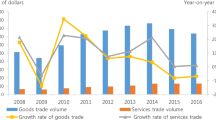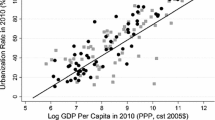Abstract
Based on a new panel data set covering exports of four Chinese port cities to 32 countries and Hong Kong over the period of 1997–2008, this paper extends the conventional gravity model to assess the impacts of transport costs and port efficiency on China’s exports. The results can be summarized as three main findings: (1) The improvements of port efficiency and reduction of road transport costs play a vital role in China’s export competitiveness in the global market. The coefficient estimates on them are relatively large, around 0.72 and −0.89, respectively; (2) The effect of transport costs and port efficiency on China-to-Asia exports significantly exceeds that on China-to-Europe and China-to-America exports; (3) The overall estimated elasticity of road, railroad and port measure is 1.66, which is almost three times that of the average wage of port cities. The empirical results provide strong evidences that upgrading China’s transport service networks should offer greater scope for maintaining and increasing its competitive edge in low cost productions. The findings offer some insights and priorities for government policy making.
Similar content being viewed by others
References
Yu L, Wang S Y, and Lai K K, Forecasting Chinas foreign trade volume with a kernel-based hybrid econometric-AI ensemble learning approach, Journal of Systems Science and Complexity, 2008, 21(1): 1–19.
Wang H, Yan G L, and Xiao Y H, Symmetry in world trade network, Journal of Systems Science and Complexity, 2009, 22(2): 280–290.
Carruthers R, Bajpai J N, and Hummels D, Trade and logistics: An East Asian perspective, Proceedings of East Asia Integrates: A Trade Policy Agenda for Shared Growth, The World Bank, Washington, DC, 2003.
Limao N and Venables A J, Infrastructure, geographical disadvantage and transport costs, The World Bank Economic Review, 2001, 15(3): 451–479.
Blonigen B A and Wilson W W, New measures of port efficiency using international trade data, NBER working paper No. 12052, Cambridge, MA, 2006.
Clark X, Dollar D, and Micco A, Port efficiency, maritime transport costs and bilateral trade, NBER working paper No. 10353, Cambridge, MA, 2004.
Wilson J S, Mann C L, and Otsuki T, Trade facilitation and economic development: a new approach to quantifying the impact, The World Bank Economic Review, 2003, 17(3): 367–389.
De P and Rout B, Transportation cost and trade competitiveness: Empirical evidence from India, Trade and Development Review, 2008, 1(2): 95–121.
Bougheas S, Demetriadesb P O, and Morgenrothc E L W, Infrastructure, transport costs, and trade, Journal of International Economics, 1999, 47: 169–189.
Nordas H K, and Piermartini R, Infrastructure and trade, ERSD working paper No. 2004-04, Geneva, 2004.
Hummels D, Transportation costs and international trade in the second era of globalization, The Journal of Economic Perspectives, 2007, 21(3): 131–154.
Iwanow T and Kirkpatrick C, Trade facilitation and manufactured exports: Is Africa different?, World Development, 2009, 37(6): 1039–1050.
Francois J and Manchin M, Institutional quality, infrastructure, and the propensity to export, Centre for Economic Policy Research working paper No. 2360, London, 2006.
Brooks D and Menon J, Infrastructure and Trade in Asia, Edward Elgar, Cheltenham, 2008.
Blonigen B A and Wilson W W, International trade, transportation networks and port choice, http://www.corpsnets.us/docs/PortDevInternalTransport/PortChoice114.pdf, 2006.
Ma L and Zhang J, Infrastructure development in a fast growing economy: The People’s Republic of China, Infrastructure’s Role in Lowering Asia’s Trade Costs (ed. by D.H. Brooks and D. Hummels), Edward Elgar, Cheltenham and Northampton, MA, 2009.
Tinbergen J, Shaping the World Economy, Twentieth Century Fund, New York, 1962.
Anderson J E and Van Wincoop E, Gravity with gravitas: A solution to the border puzzle, American Economic Review, 2003, 93: 170–192.
Egger P, An econometric view on the estimation of gravity models and the calculation of trade potentials, The World Economy, 2002, 25: 297–312.
Tiwari P, Itoh H, and Doi M, Shippers’ port and carrier selection behavior in China: A discrete choice analysis, Maritime Economics and Logistics, 2003, 5(1): 23–39.
Hausman J A, Specification tests in econometrics, Econometrica, 1978, 46(6): 1251–1271.
Wooldridge J M, Econometric Analysis of Cross Section and Panel Data, The MIT Press, Massachusetts, 2002.
Greene W, Econometric Analysis, Prentice-Hall, New York, 2000.
Friedman M, The use of ranks to avoid the assumption of normality implicit in the analysis of variance, Journal of the American Statistical Association, 1937, 32: 675–701.
Hoechle D, Robust standard errors for panel regressions with cross-sectional dependence, The Stata Journal, 2007, 7(3): 281–312.
Baier S L and Bergstrand J H, The growth of world trade: tariffs, transport costs, and income similarity, Journal of International Economics, 2001, 53: 1–27.
Bergstrand J H, The generalized gravity equation, monopolistic competition, and the factor-proportions theory in international trade, Review of Economics and Statistics, 1989, 71(1): 143–153.
Oguledo V I and MacPhee C R, Gravity models: A reformulation and an application to discriminatory trade arrangements, Applied Economics, 1994, 26(2): 107–20.
Hummels D and Skiba A, Shipping the good apples out? an empirical confirmation of the Alchian-Allen conjecture, Journal of Political Economy, 2004, 112(6): 1384–1402.
You J H, Xie S Y, and Zhou Y, Two-stage estimation for seemingly unrelated nonparametric regression models, Journal of Systems Science and Complexity, 2007, 20(4): 509–520.
Author information
Authors and Affiliations
Corresponding author
Additional information
This research is supported by the National Natural Science Foundation of China under Grant Nos. 71101142 and 70903067.
This paper was recommended for publication by Editor Wang Shouyang.
Rights and permissions
About this article
Cite this article
Xu, L., Fang, SC. & Zhang, X. Transport costs and China’s exports: Some empirical evidences. J Syst Sci Complex 26, 365–382 (2013). https://doi.org/10.1007/s11424-013-1259-6
Received:
Revised:
Published:
Issue Date:
DOI: https://doi.org/10.1007/s11424-013-1259-6




